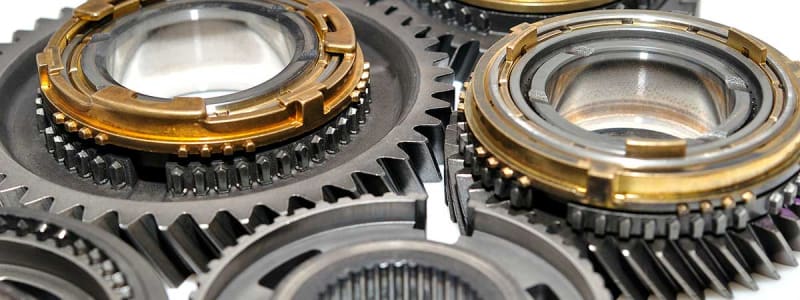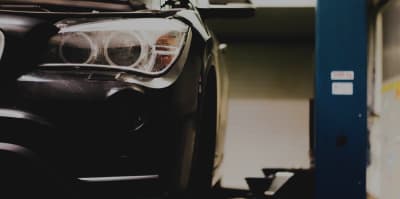
We assume that all motorists pretty much know what the gearbox in the car is used for - but it's probably far from anyone who knows how it actually works. In addition, there are many different types and installments of the gearbox. Read more here and learn how gears work.
The transmission is a basic part of your car. It is mounted directly on the engine and converts the engine’s combustion power to momentum which drives the wheels.
The gearbox is responsible for efficient driving. By changing gears, you ensure that the RPM’s (Revolutions per Minute) are kept low so that the engine is not overloaded and that fuel consumption is lowered. The transmission is responsible for converting both speed and momentum into power that then gets the entire car moving and its main aim is to make the engine as efficient as possible by reducing the amount of fuel consumption whilst getting the best amount of power.
In other words, the transmission works by transmitting the power that comes from the engine to the wheels along the drive shaft and axle allowing you to drive the car.
It does all of this by using gears and gear ratios that are selected either automatically or manually by the driver.
In a car with manual transmission, the clutch will bridge the engine and transmission, so you can change gears when you press the clutch pedal. In an automatic gearbox, this happens completely automatically.
In your service manual, you can see when it is time to change the oil in your gearbox. It is an integral part of any vehicle maintenance and is usually included in a service inspection. Even small things can cause great damage to the gearbox. So if you notice it behaving differently than it used to, you should have a mechanic to inspect it.
Are you considering fixing the transmission yourself, here's a guide.
If you are facing a car purchase, it might be a good idea to consider what kind of gearbox you should choose - because it is an option in some car classes. In this article, we will help you get started so you can make the right decision. We also help you get an overview of the many types of gearboxes found in modern cars and how they work.
Manual gear vs automatic transmission
In a car with a manual transmission, there are 5 or 6 forward gears and 1 reverse gears that the driver of the car changes between, while cars with automatic transmission perform the necessary gear changes automatically.
British car owners have traditionally and predominantly driven manual gear. Autobutler's mechanics estimate that about 80% of the total British car fleet has manual gear. However, the number of automatic transmission cars on the roads has increased a lot over the past 30 years.
In 1985, only 5% of British cars had automatic transmission, while 20% own a car with automatic gears today. In 2017, 40% of the cars sold to the British market had automatic gears - so the Brits are getting more used to this kind of transmission.
The benefits of driving a car with automatic transmission are, of course, that you do not have to change gears at all. It's about comfort. Especially when driving in queues, it is incredibly nice to have automatic transmission, so you don't have to concentrate on gear changes.
If you buy a car with a manual transmission, however, you will enjoy the feel of the control and grip with the gear change. Many car owners like the feel of having the manual transmission control. Besides this, for some cars it also seems like the manual gear is cheaper to maintain in the long run.
Automatic transmission - how it works
The "ordinary" automatic transmission is electronically controlled in the gearbox and operates on a hydraulic system. And since the gearbox is designed to change to a new gear when the revolutions of the car change, it also means that the fuel economy is good with automatic transmission.
As the name suggests, the driver of the car does not have to switch gears manually. The most common settings of the gear stick are P for parking, R for reverse, N for neutral, and D for drive.
Read more in our blog on how to drive with automatic transmission.
Automatic gearboxes are often designed so that in the center of the gears there is a large cogwheel - the “sun gears” - which transmits the power from the engine. Around the cogwheel are a number of small gears, called planet gears (like planets around the sun). They have different sizes and can also be interconnected and separated. And encircling them is another large cogwheel, which transmits the power from the planet gears, which then transfers the power to the wheels. Gear shifts occur in a fluid transition between the various planet gears, which makes driving smoother and quieter than if you have to disengage and engage through the clutch with manual gears.
Many cars from e.g. Ford has a version of automatic transmission called Power Shift. It works by having the gears reacting to the pressure on the accelerator even better and subsequently get a better grip - so if you step hard on the speeder, the car can accelerate relatively better and faster.
In addition, there is a CVT (Continuous Variable Transmission) gearbox on the market. It’s characterized by having a single chain or belt which adjusts between two drums, depending on speed and revolutions. In this automatic gearbox, the transition is therefore even more smooth than when you have a gearbox with gears and shafts.
It is important to remember regular servicing of the car's fully automatic transmission. This is because the gearbox is more prone to direct damage and wear over time than manual gearboxes, where the clutch is more exposed to wear. For the service inspection, the fully automatic gearbox must be cleaned of deposits and other wear-related contaminants in the gearbox oil.
Semi-automatic gearbox
In a semi automatic gearbox, the clutch is still a part of the transmission (but not the clutch pedal), while a computer maintains the gear changes automatically.
How the semi-automatic gearbox works in practice is very different from car to car. In some cars, you do not do anything at all when changing gears and can let the engine and electronics do the work for you.
In others, you need to "tell" the engine when you want to gear up or down. You push the gear lever in the direction you want, and then the electronics shift gears for you. The actual change is made in a so-called "actuator".
Finally, other cars give you the option to choose for yourself whether you want to be completely hands-free or use the gear stick for gear changes.
From a financial point of view, buying a car with a semi-automatic transmission can be advantageous because it requires less maintenance in the long run. If something breaks in the fully automatic gearbox, the mechanic has to go all the way into the gearbox to repair it and this can be expensive. With the semi-automatic gearboxes, you have a clutch, which is the part mostly exposed to wear, rather than the gearbox, and the clutch is somewhat cheaper to repair than the gearbox is.
The cars most often equipped with semi-automatic gearboxes are Peugeot, Citroën, Volkswagen, Audi, Škoda and Seat. Of course, each brand can have their own way of designing the gearbox, but these are the typical car brands that use the semi-automatic system.
DSG-gearbox
The DSG gearbox is in a way a mix between manual and automatic gear, in that there is a clutch in the car. This is unlike other fully automatic gearboxes. There is no clutch pedal, but the function of the clutch itself is retained in a dual clutch, which provides for easy and quick gear change.
This gearbox is most often found in Audi, Škoda and Volkswagen cars, and thus generally in the larger German vehicle fleet.
Some problems with the DSG gearbox are that you need to be more careful with its maintenance. If you do not get service on the DSG gearbox, and make sure to have the gearbox oil and oil filter changed, it can only last a relatively short time compared to the manual gearboxes. You should preferably have a service inspection done per 38,000 miles traveled because the gears in the gearbox may be affected by wear-related dust and sediments.
Sequential gearbox
Some cars also have a sequential gearbox where, as the name suggests, you have to pass each gear whether you are gearing up or down. You therefore shift gears in sequences on a pair of cogwheels, and unlike the manual gearbox, you can only switch to a gear that comes before or after the current one. This is because the gears are "in line" as opposed to the H format, which you know from a manual transmission. Finally, the advantage is that you can shift between the gears faster and get a faster acceleration, which is why the sequential gearbox is found in many racing cars.
Active Shift Control
Recently, Hyundai developed an improved version of the transmission in hybrid cars. The hybrid car is special in that it has both a gasoline and an electric motor. The great advantage of this car is that it uses the electric motor at times when ordinary petrol cars have the highest fuel consumption - especially during start-up and acceleration.
In other words: When fuel consumption is highest, the hybrid car uses the electric motor. This gives a really good fuel economy and is also good for the environment.
However, Active Shift Control technology does even more for fuel economy, gearshift and gearbox durability. At the same time, the acceleration is getting better.
This is done by ASC, also known as Precise Shift Control, which optimizes the momentum and transfer of power to the wheels by streamlining the gear shift speed. This is achieved by a sensor in the electric motor detecting the revolutions in the gearbox, which is then synchronized with the electric motor. This one will then step in when gears are changed. In this way, energy losses are avoided by up to 30% due to the more smooth gear shift, where the electric motor keeps the car's revolutions high throughout the shift. The gear change time is reduced from 500 milliseconds to 350 milliseconds and the friction in the gearbox is less - which increases durability.
The technology is first introduced in Hyundai hybrid cars, and then in the well-known Kia models.







